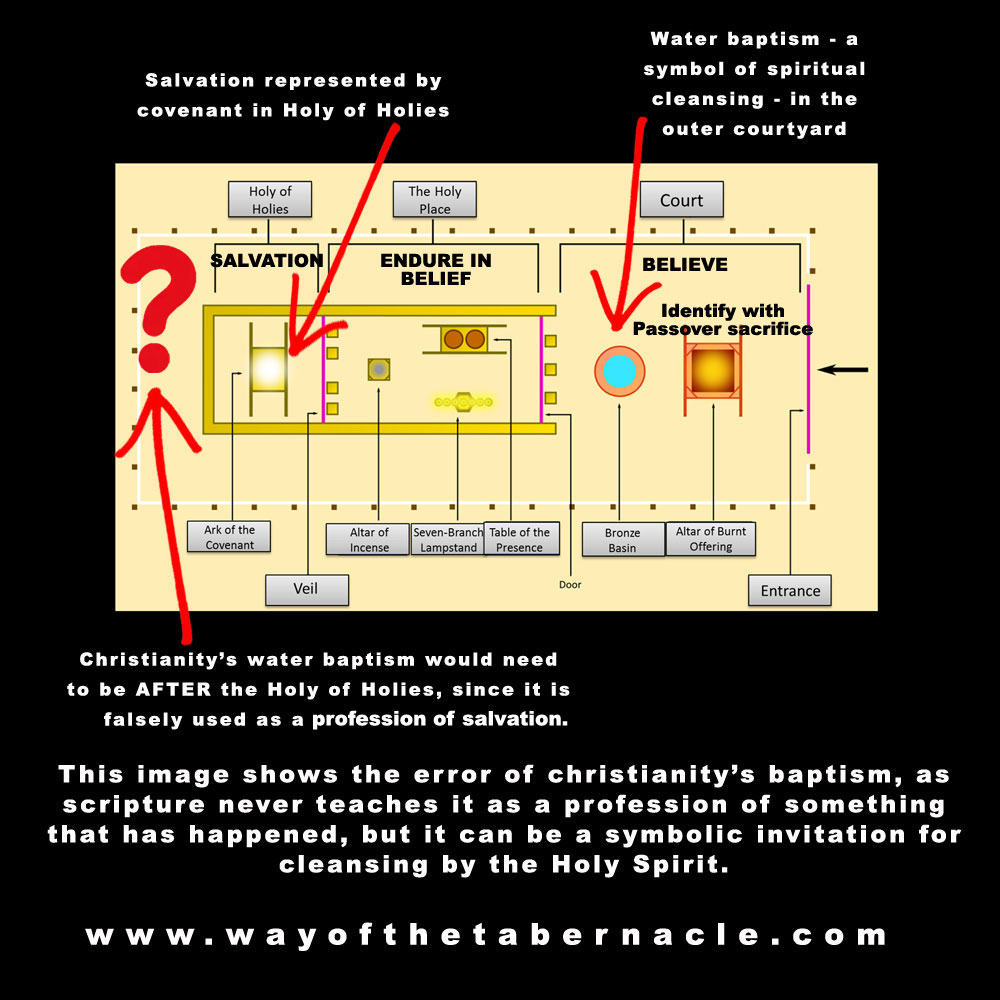CHRISTIANITY'S HOLY SPIRIT-SOME WATER AND A BOOK
The typical baptism of christianity happens after someone makes a decision, prays a prayer, “accepts” Christ, or any of a multitude of christianese euphemisms for salvation that aren't actually salvation.
Such a person declares that he has been saved because of something he did or said, and then he is scheduled for the big step of getting in front of some folks to get wet. In most “churches,” that step then allows the person to join the club, hold a position, and be solicited for money at least weekly.
Because the “church” lacks spiritual understanding, being a counterfeit of the true faith, most have no idea what the correlation is between the physical and the spiritual—the foreshadow and the real substance. They don't realize that in some of those constructs in scripture, both the physical and the spiritual are called the same thing, and yet, are different.
“Jew,” “Israel,” “covenant,” and “circumcision” demonstrate the physical foreshadowing of the spiritual. With each of those terms, there is a physical aspect that was a foreshadow of a future-revealed spiritual real substance. The actual meaning is always the spiritual, as the physical only presents a picture, or shadow, of the real thing. “Ark of the covenant,” “temple,” “tabernacle,” and “priesthood” are also all physical foreshadows of the bride.
“Baptism” is one of those terms. Water baptism was under the law, and it foreshadowed the cleansing of the Holy Spirit, which is the true meaning of baptism. When Messiah Yahoshua was baptized with John the Baptist as His witness, He demonstrated both the physical foreshadow under the law (water), and then the spiritual real substance (Holy Spirit).
Baptism in water, at the most, can be an invitation to the Holy Spirit. It is not a declaration of anything that has purportedly already happened. Christianity uses it as a “post-event” declaration because christianity doesn't teach the true meaning of being born again, but a counterfeit of it that is declared solely by man.
In the admonition to “repent and be baptized,” the “repent” part refers to the only sin that condemns: unbelief. It has nothing to do with multiple sins of the flesh that have been committed, as they have nothing to do with salvation. To repent of unbelief simply means to believe. The “be baptized” part happens at some point after one believes (because simply “believing” is not salvation).
The “be baptized” part refers to receiving the Holy Spirit. And, those who have the Spirit reproduce others with the Spirit, which is why the disciples were told to go and baptize others. It had nothing to do with getting wet, physically. We see Peter and John doing just that in Acts 8:17. The Samaritans had already gotten wet physically, but were not yet saved. Peter and John did not put those folks in water again after they received the baptism of the Holy Spirit.
The diagram of the tabernacle (below) shows just how christianity perverts the true meaning of baptism. In the outer courtyard are the brazen altar (the sacrifice) and the laver (baptism). To be saved is to receive the covenant. So, where, in the progression shown, is the covenant?
It is not in the outer courtyard, as christianity falsely teaches, but is in the Holy of Holies. The altar represents identifying with the sacrifice, and the laver represents being cleansed from the sin that condemns (repenting of unbelief, which is to believe)
The perversion of baptism by christianity would require another place in the tabernacle BEYOND the Holy of Holies, where a water baptism could take place after one has received the covenant—and that place would need to have room for an audience.
Moreover, christianity's false baptism would preclude the thief on the cross from being saved, for he did not get himself all physically wet in front of people after he believed. No, he received the only baptism that is necessary—the baptism of the Holy Spirit.
Scripturally, water baptism never followed salvation, but preceded it. It was a foreshadow, not an afterthought.
Since water baptism only foreshadows the work of the Holy Spirit, using it as a purported declaration of something that has happened then replaces the true role and authority of the Holy Spirit, and the unwitting christian then rests some of his eternal security on the false doctrines of his water baptism. The misguided christian replaces the Holy Spirit's personal, direct, and unique confirmation of salvation with his own declaration, and thinks that getting physically wet in front of people seals his justification before the Father.
Just as christianity counterfeited the Passover with the Lamb-less knockoff called “communion,” it has baptism all wrong, too—getting untold millions of people wet for no good reason. Christianity replaces the Holy Spirit's declaration of salvation with a pool of water, and since their counterfeit is missing the true role and authority of the Holy Spirit in its religion, countless millions of misguided christians will be so shocked on that day when they hear, “Depart from Me, I never knew you.”
In like manner, and from the same lack of spiritual understanding, christians replace the true role and authority of the Holy Spirit with their bibles. Just as they use water baptism to declare their salvation, they falsely use their English translations of the scriptures to “confirm” their salvation, and they actually believe that citing specific verses proves they have been given the Holy Spirit. The entire notion is absurd, when one understands the true purpose of the scriptures, and the power that lies, not in the words themselves, but in the Author of the words.
One of the sources of this entire false construct of “bible-as-Holy-Spirit” comes from honest ignorance of the meaning of the word “WORD.” English translations of scripture use the word “word” for two different things—one is a living being, and one is actual words. But, if one doesn't know which of those things a passage is referring to, then the actual meaning of the verse cannot be understood.
The Hebrew DABAR and IMRAH, and the Greek LOGOS and RHEMA all get translated as “word” in the English translations.
The Hebrew IMRAH and Greek RHEMA are equivalents. They are utterances. So the RHEMA of Yah are His utterances—His statements. And, the focus is the actual words themselves.
The Hebrew DABAR and Greek LOGOS are equivalents. They are also utterances, but the focus is the one doing the speaking. So, when the Word (DABAR) came and spoke to the prophets in the OT, it was not a scroll, nor was it any written words. It was the living being who was producing the utterances of Yah. It was the Holy Spirit.
Messiah Yahoshua is the Word (LOGOS) made flesh. He was here, but then He HAD to go away (the wedding traditions required it), so another was sent in His place, and He is the Word (LOGOS) to the bride (“He will lead you into all truth, and tell you of the coming things” -John 16:13). Thus, christians, ignorant of the actual meaning of the words used in the original languages, think their bibles are the “word of God.” They aren't.
Their English bibles are a translation of the RHEMA, they are not the LOGOS. And, only the LOGOS can confirm one's salvation. Christians falsely believe that their translation of the RHEMA can confirm they have been given the Holy Spirit, and there is simply no way that can, or ever will, happen. In so doing, christians replace the Holy Spirit with their human translation of the scriptures.
Hebrews 4:12 says nothing about scripture. It is speaking of the Holy Spirit.
So, instead of the Holy Spirit being the One who declares that one has been made righteous (justified), and who confirms that the believer has been adopted as a child of Yah, christianity teaches that man declares his own salvation with water baptism, and points to written words as the confirmation of that salvation. This is a clear counterfeit of the truth.



Written by Dean Haskins for Way of the Tabernacle. Reproductions with proper attribution are allowed and encouraged.
Salvation
Traditions
Other Truths
But now in Yahoshua the Messiah you who formerly were far off have been brought near by the blood of Christ. For He Himself is our peace, who made both groups into one and broke down the barrier of the dividing wall, by abolishing in His flesh the enmity, which is the Law of commandments contained in ordinances, so that in Himself He might make the two into one new man, thus establishing peace, and might reconcile them both in one body to Yah through the cross, by it having put to death the enmity. Ephesians 2:13-16




